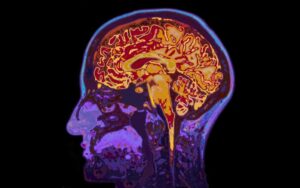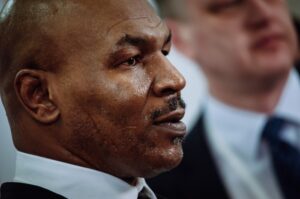In early November, Microdose’s Wonderland Miami event welcomed not only some big names in the psychedelics space but from the sports world as well. Former professional athletes like the boxer Mike Tyson, the NHL’s Daniel Carcillo and Riley Cote, and the NFL’s Eben Britton all touched down in the city to share their experiences with psychedelic therapies.
Many of the discussions that took place zeroed in on how psychedelics could benefit athletes not only after their career in sports, but during. From healing traumatic brain injuries to acting as a tool for addiction recovery or pain management, psychedelics are presenting themselves as the pathway to a healthier sporting world.
A psychedelic life after sports
In a discussion that seemed far removed from typical sports injury talk about on-the-field injuries like torn rotator cuffs or sprained ACLs, athletes like Carcillo opened up about traumatic brain injuries (TBI) and how traditional “white coat” interventions left him hopeless and contemplating suicide. The long road he took to psychedelic therapy, he told the Wonderland Miami audience, “saved my life and continues to on a daily basis … This medicine allows me to be in the present moment with my kids, my business, my friendships.”

For Carcillo, personal experience with the medicine evolved into a mission: to get the FDA to approve psychedelics as the first pharmaceutical treatment for TBI — and he’s got none other than Tyson in his corner. The champion boxer with a troubled past says that his experience with psychedelic medicines led him to consciousness, compassion, kindness, and an escape from ego. “I’m the guy [when] if someone asked me for an autograph, I was so insecure I might knock them out cold,” recalled Tyson, referencing his mental state before he began using the medicine. “I need to be contained and this contains me.”
Ketamine: breaking the addiction and chronic pain cycle
Tyson was not the only athlete to be honest about his struggles with addiction at Wonderland Miami. While he cited alcohol and cocaine as the crutches he was dependent on, other athletes battled addictions to drugs prescribed to them by their team doctors — painkillers like opioids.

Dr. Michelle Weiner, an integrative pain management physician, says that ketamine can be a superior tool for healing chronic pain as opposed to the addictive and dangerous band aid-type solution that opioids have been proven to be. Weiner explained that ketamine works to dissolve the ‘I am my pain’ identity of chronic pain sufferers, giving them a mental break from the physical pain (which, as any chronic pain sufferer knows, is psychologically exhausting). Her approach goes further than treating the physical body, instead looking at trauma, mental health, and physical health holistically.
Dr. Ben Sessa, Chief Medical Officer at Awakn Life Sciences says that ketamine treatment could put an end to the addiction treatment world’s history of ”throwing good money at poor outcomes,” adding that no other field of medicine would accept the low success rates that medical intervention in addiction issues has seen up until now.
Zappy Zapolin, a panelist who calls himself a psychedelic concierge, worked with former NBA star Lamar Odom after Odom suffered multiple overdose-induced strokes, heart attacks, and liver failure after mixing copious amounts of cocaine and alcohol over the course of a weekend in 2015. Odom’s psychedelic therapy began with ketamine and is documented in the 2021 film “Lamar Odom Reborn” which shows the NBA star’s therapeutic journey to cope with addiction and the past traumas at the root of it.
Prevention and performance at Wonderland Miami
While athletes like Tyson and Odom looked to psychedelics to heal past traumas, other Wonderland Miami speakers were thinking about psychedelics and the future of sport. Joe Moore, the Co-Founder and CEO of Psychedelics Today, spoke about his prognostication for the psychedelic space over the next ten years. “We think that we’re going to move from psychedelics for a diagnosis to psychedelics as a mechanism of coaching therapy for the general public,” he said. “Not just as a safety net, but for the human athlete, for corporate, for the individual.”
A nuanced Wonderland Miami discussion about the “paradox of microdosing” laid out the facts and fictions behind a practice that’s gone from subculture to mainstream at a rapid pace. Several panelists referenced the work they are doing to back up the anecdotal evidence reported about microdosing, saying that some of the focus is on discounting the placebo effect. Judy Blumstock, CEO, Director & Founder of Diamond Therapeutics described her company’s clinical research on low psilocybin doses in rats which don’t experience a placebo effect. Their paper, published in Frontiers in Pharmacology, showed the psilocybin microdoses increased attention and motivational behaviour in the animals.

As with so many practices meant to enhance health and wellbeing, microdosing works differently with different individuals, something that panelists in this made sure to highlight. Gregory Ferenstein, CEO of Frederick Research, said that his own microdosing regimen, which he pairs with meditation, has helped him “understand what [his] anxiety is trying to tell him” and has “transformed his social life.”
Panelist Dr. Erica Zelfand of Simba Health is someone for whom microdosing produced little effect, but has seen it change the lives of some of her patients. She offers warnings for certain patients who she feels should avoid psychedelic medicine including those with generalized anxiety disorders or a history of psychosis or mania.
What the panelists agreed on was that psychedelics are medicine that offer the most to people when they’re combined with intention, process and patience. “It’s not a quick fix,” said Earth Resonance CEO Natasha de Jong while other panelists described microdosing as “an intentional protocol over 30 or 60 days, two to three times a week” as well as “a commitment” and “an exploration.”
In terms of the medicine’s potential in the sports world, the discussion revealed ways in which microdosing therapy is a good fit for athletes. Dr. Zelfand sees the therapy working best for people “willing to take an active role in their healing” and who are practiced goal-setters. The therapy is typically part of a virtuous cycle — people who want to do it are drawn to naturally healthy practices. All of the above, of course, describe the typical athlete, whether they engage in their sport at the professional level or as amateurs.

